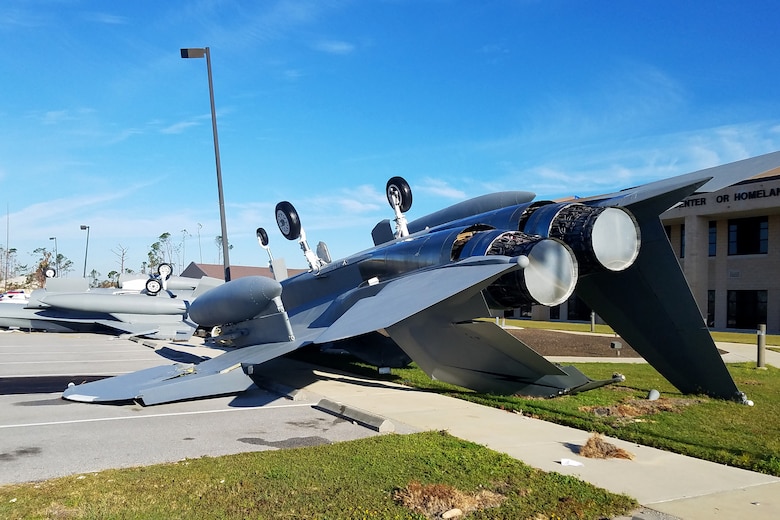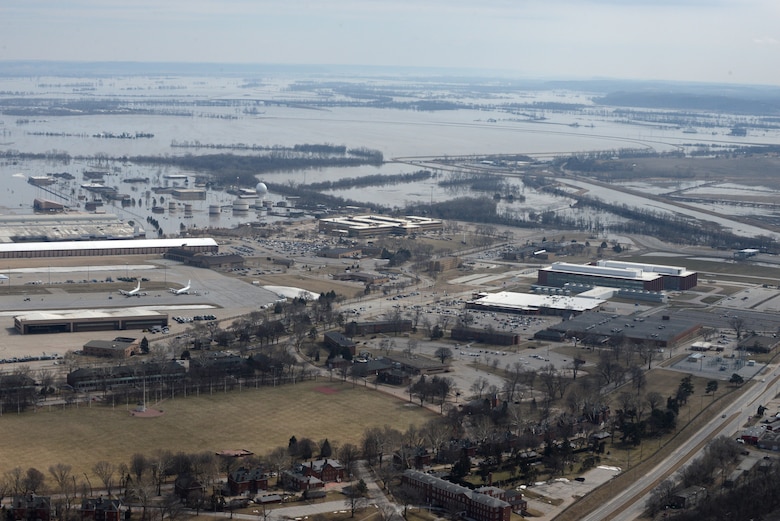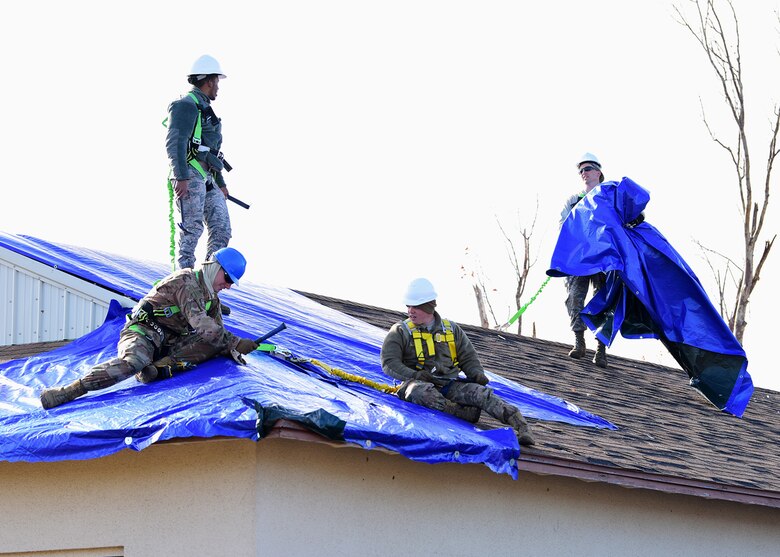First, it was Hurricane Michael, a Category 5 storm with sustained winds of 155 mph and pure destruction as the storm's eye passed directly over Tyndall Air Force Base, Florida, Oct. 10, 2018. A few months later and nearly 1,000 miles away, it was the icy waters of the Missouri and Platte rivers that engulfed nearly one third of Offutt AFB, Nebraska, following record rainfall and melting snow breaching nearby levees.
In less than six months, natural disasters shut down two major bases and bottlenecked critical training and mission operations for months. Initially, the Air Force Civil Engineer Center Facility Engineering Directorate managed both of these recovery and rebuild projects through separate program management offices.
They are now aligned under a new program office, the Natural Disaster Recovery Division, focused on recovering bases like Tyndall AFB and Offutt AFB and rebuilding them with adaptive, resilient, right-sized and fiscally sustainable infrastructure that enhances combat power.
"Installations are the foundation of Air Force readiness and lethality … they provide air power, training and they're home to countless Airmen, Guardians and their families," said Col. Travis Leighton, NDRD chief.
The division will serve as a strategic reserve of expertise equipped to tackle current and future natural disasters with capabilities that include damage assessment, requirements development and construction execution. The division also has a responsibility to ensure installations are more resilient to future natural disasters, Leighton said.
At Tyndall AFB, the division is tackling a five-to-seven-year rebuild effort that includes 44 new military construction, or MILCON, and 260 facility sustainment restoration and modernization, or FSRM projects, valued at $4.9 billion.
The new NDR mission is one component of a broader AFIMSC approach to managing infrastructure following the 2019 Air Force release of an Infrastructure Investment Strategy that provided a stark analysis of the degrading condition of the force's 180 installations. The AFIMSC enterprise is rolling out new approaches and analytical tools developed to restore installation readiness through cost-effective modernization, innovation and mission-needs-based prioritization.
Part of the change includes a new capabilities-based program management framework that unifies programs through a corps of CE program executives.
Dubbed the "Unity of Effort" initiative, Maj. Gen. John Allen, AFCEC commander, said the new framework provides more stringent oversight and management for high-visibility, complex programs with multiple stakeholders and contributors.
"The program executives will form a corps that acts as a single champion for the CE enterprise," Allen said. "The end state is aligning policy, planning, programming, execution and sustainment to meet mission requirements for on-time, on-schedule and on-budget delivery of capabilities."
AFCEC's initial five capabilities-based programs include: environmental compliance and restoration, housing portfolio management, energy assurance, integrated base response and recovery, and built infrastructure investment and recapitalization, or BII&R.
Led by Brig. Gen. Mark Slominski, the BII&R initiative champions adaptive, resilient, right-sized and fiscally sustainable infrastructure. As the built infrastructure program executive, Slominski is responsible for aligning AFIMSC and AFCEC personnel with key stakeholders and mission partners into project delivery teams to effectively manage the scope, schedule and budget for all active component MILCON and FSRM efforts.
With an abundance of large-scale projects and billions of dollars, Slominski said the NDR program is an example of the BII&R initiative in action. NDR program lessons learned are leveraged to inform the framework for how AFCEC delivers major MILCON and operations and maintenance-funded projects as matrixed teams from across the Department of the Air Force, Army Corps of Engineers and Navy Facilities Command.
"Offutt (AFB) and Tyndall (AFB) represent significant investments," Slominski said. "We're looking at an initial MILCON investment of more than $3.6 billion, and a full-lifecycle cost of roughly $9 billion. We are building resilient, efficient and innovative installations of the 21st century that serve as benchmarks for the Department of Defense."
While the NDR has all the money it needs for Offutt AFB and Tyndall AFB through fiscal year 2021, the BII&R initiative will play a key role in helping AFIMSC identify vulnerabilities and make targeted investment decisions to strengthen installation readiness enterprise-wide.
AFIMSC recently released a strategic plan that outlines major lines of effort and related goals that support Air Force priorities like delivering new analytics, tools and management practices that help commanders identify where investments need to be made.
In February, AFIMSC deployed a new dashboard for Facilities Activity Management Planning. The online dashboard is a suite of three tools and feeds in mission index data from six sustainment management systems. Combining these scores with mission dependency indicators, AFIMSC can provide installations with a 10-year outlook on their facilities' requirements. With this information flowing up from the installations, and more AMP dashboards in development, installations can track and report requirements for life cycle asset management planning further out and help the Air Force reverse-engineer funding and procure contracting services before mission failure becomes a risk.
Through the NDR program, installations may be able to capture and share this data with AFIMSC in real time.
For example, the NDR team is fielding an installation resilience operations center, or IROC, prototype that gives Tyndall AFB the ability to centrally collect, share, integrate and analyze data. That data is then used for predictive maintenance and to conduct live monitoring of facility conditions.
"The applications for the IROC are almost limitless … from increasing safety and security of our Airmen to driving cost-effective management of our built infrastructure," Leighton said. "This prototype has the potential to drastically change how we operate and maintain our installations."

A team of nine U.S. Airmen from the South Carolina Air National Guard's 169th Civil Engineer and Medical Squadrons volunteered to help nudge Tyndall Air Force Base in Florida toward recovery after Hurricane Michael left the base in near complete destruction October 22-28. (U.S. Air National Guard courtesy photo)

Shown is an aerial view of Offutt Air Force Base, Neb. and the surrounding areas affected by flood waters March 17, 2019. An increase in water levels of surrounding rivers and waterways caused by record-setting snowfall over the winter in addition to a large drop in air pressure caused widespread flooding across the state of Nebraska. (U.S. Air Force photo by Tech. Sgt. Rachelle Blake)

Task Force Phoenix Airmen repair a damaged rooftop at Tyndall Air Force Base, Fla., Nov. 28, 2018. Task Force Phoenix is responsible for large-scale clean up and reconstruction after Hurricane Michael ravaged the 325th Fighter Wing. (U.S. Air Force photo by Senior Airman Isaiah J. Soliz)






